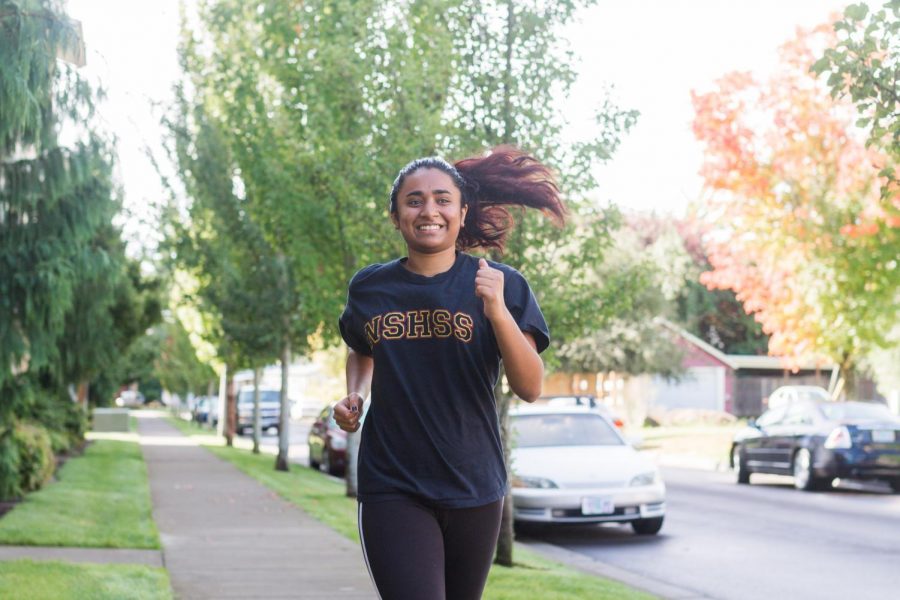Amid Oregon gym closures, OSU community finds new ways to stay active
March 29, 2020
Dixon Recreation Center, Oregon State University’s gymnasium, closed all their indoor sport facilities to reduce the risk of spreading COVID-19 until April 28.
Per Gov. Kate Brown’s Executive Order 20-12, all Oregon gyms, sports and fitness centers, health clubs and exercise studios are temporarily closed. Those who want to remain physically active during the coronavirus outbreak have to do so within their homes, or while practicing social distancing outside, which requires a six-foot distance between others.
In an email, Brian Hustoles, MBA, marketing and communications manager of Oregon State University Recreational Sports, said beginning Saturday, March 21, students and other Recreational Sports members were able to check out equipment to use while engaging in recreational activities in Student Legacy Park, which is located across the street from the Dixon Recreation Center, but this program has been suspended in order to comply with Gov. Brown’s Executive ORDER 20-12.
Katelyn Kirk, instructor in the College of Public Health for Physical Activity Courses and Kinesiology, and Administrative Operations Support for Physical Activity Courses said via email, people should try to stay active, whether that is working out in their home, walking in their neighborhood, following a virtual workout which is offered by both PAC and Faculty Staff Fitness at OSU or other virtually-led options.
“Observe [Centers for Disease Control and Prevention] social distancing guidelines when you do, but it would be unhealthy for most people to not step outside at least once a day. Take that opportunity to say hello to neighbors or friends. Social distancing does not mean social isolation,” Kirk said in an email.
Kirk, who also works as a group fitness coach and personal trainer at Anytime Fitness in Albany, Ore., said in an email people should help their friends and family stay active and go outside.
Victoria Elligsen, a fourth-year history and anthropology double major, said via email her main gym is Dixon, and she usually weight-lifts for two hours, five to six days of the week. Since the closure of dining-in for restaurants and other nonessential businesses has been announced, she hasn’t been able to go to the gym, but she has figured out other ways to stay active.
“I’ve returned home for break, so I’ll spend a lot of time walking the dog and doing high-intensity interval training workouts and makeshift home weights where possible,” Elligsen said in an email.
Emmanuel Ughelu, a second-year masters student in the kinesiology program, said via email he normally works out four to six times a week at Dixon, depending on his schedule. He also plays soccer twice a week with the OSU Men’s Soccer Club, does resistance training three times a week and HIIT cardio once a week. Since the gym closures started, his routine has changed.
“For starters, no more soccer practice. I’m still able to engage in some resistance training since I have some weights and bands. However, these are not as effective as an actual gym,” Ughelu said in an email. “The variety of machines and weight at the gym makes training a lot more effective. I’m still able to do some training here at home, but it’s far less ideal.”
He currently does a lot of jump-roping at home, some shadow boxing, and takes walks to keep himself active. He also uses his weights and bands for resistance training at home to complement his fitness routine.
Kirk said people who enjoy lifting weights and don’t have the equipment, can use something around their house like water jugs, paint cans, soup cans, or even stacks of books.
For people that want to do cardio, Kirk said they could try going for walks, jog, climb their staircase, get outdoors and ride a bike.
“I am following the same workouts that I am virtually coaching to my students and clients. I am fortunate to have a small collection of home gym equipment, but I am also using a case of water and some soup cans,” Kirk said via email. “I personally prefer shorter HIIT workouts for at-home sessions. I have my adorable dog Rose, who I walk at least twice daily which gets me outside and moving.”
In an email, Hustoles said the department of recreational sports programs area is going to have a variety of virtual intramural activities, including e-sports, app games, weekly trivia, a virtual running group and a step count competition. Also, the Adventure Leadership Institute is offering three remote programs each week, including such programs as Hiking in the Age of Social Distancing, Nature and Health, and Community Building in the Age of Social Distancing.
“Group Fitness will provide a full complement of over 40 classes per week, taught by favorite Rec Sports instructors. We’ll have multiple strength and yoga classes, as well as Zumba and a new, guided mindfulness class,” Hustoles said in an email. “Personal trainers will be available for one-on-one Zoom appointments. All activities can be done with body-weight and things you can find around the house.”
Additionally, Dixon will offer wellness coaching to help students find an activity and recreation community that shares their interests. All previously-mentioned events are free to Rec. Sports members.
“Recreational Sports sent a communication to members who have a locker rental indicating times that they could access Dixon Recreation Center to retrieve their items,” Hustoles said via email. “This was an optional opportunity for participants. All items that are left in lockers will be kept safe throughout the duration of the temporary suspension of locker service.”
Hustoles said given the uncertainty surrounding Dixon’s reopening date, his team at Dixon Recreation Center is still in the process of determining how best to administer reimbursements.















































































































